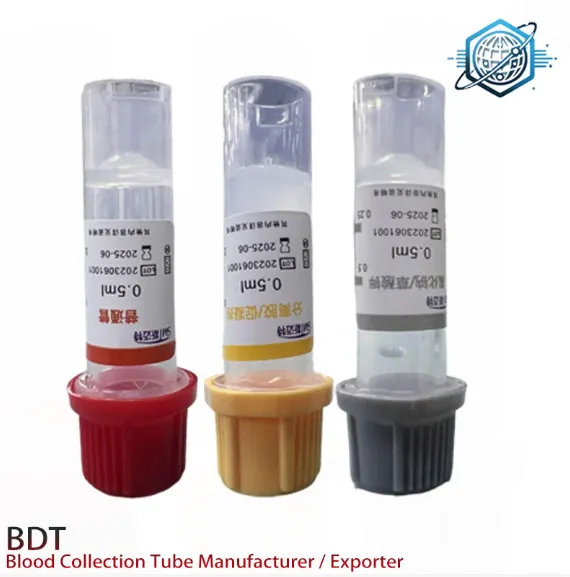- bdttonyjiao@hotmail.com
- +86 +8615081115902
- 9-1-701 TonfuTown Місто Шицзяцзуан Провінція Хебей Китай
Тра . 26, 2025 16:11 Повернутися до списку
Vacuum Blood Collection Tubes: Essential Tools in Modern Hematology
In clinical diagnostics, precise and safe sample collection is the cornerstone of accurate laboratory testing. Among the most widely used methods for blood sampling is the vacuum tube blood sample system. These tubes offer a closed and sterile method of collection that minimizes contamination and ensures the integrity of the sample. This article explores the functionality, types, and applications of vacuum tube collection, with a specific focus on vacuum tube EDTA and the vacuum tube for CBC testing.

What is a Vacuum Tube Blood Sample?
A vacuum tube blood sample is collected using a specially designed test tube that contains a pre-measured vacuum. This vacuum creates negative pressure inside the tube, enabling blood to flow directly from the patient’s vein into the tube when connected via a double-ended needle and holder. This method is part of the evacuated blood collection system, which has become the gold standard in phlebotomy.
Vacuum tube blood sample collection is favored for several reasons:
Safety: Minimizes the risk of blood exposure to healthcare workers.
Accuracy: Delivers consistent volume per tube for standardized testing.
Efficiency: Allows for multiple samples to be drawn quickly using different tubes for various tests.
These tubes are typically color-coded according to their additive and intended use, enabling laboratory staff to easily identify and sort them.
How Vacuum Tube Collection Works
The vacuum tube collection process involves the use of three main components:
A vacutainer holder (also called a hub).
A double-ended needle, one side of which goes into the patient's vein and the other into the tube.
A vacuum blood collection tube, pre-labeled and pre-filled with an additive, if necessary.
Once the needle punctures the stopper of the vacuum tube, the pressure differential pulls blood into the tube. This method is highly efficient and enables multiple tubes to be filled from a single puncture by simply switching tubes while keeping the needle in place.
Vacuum tube collection is used for:
Biochemical tests
Serological testing
Hematology
Coagulation studies
Blood cultures
This system not only improves workflow in clinical laboratories but also enhances patient comfort by reducing the need for multiple needle sticks.
Vacuum Tube EDTA and Its Application
One of the most essential tubes in any laboratory is the vacuum tube EDTA. This tube is typically color-coded lavender or purple and contains ethylenediaminetetraacetic acid (EDTA) as its anticoagulant. EDTA works by binding calcium ions, thereby preventing the blood from clotting.
The vacuum tube EDTA is primarily used for hematological examinations, where the integrity of blood cells must be preserved.
Key uses of vacuum tube EDTA:
Complete Blood Count (CBC)
Hemoglobin and hematocrit analysis
Blood typing and crossmatching
Molecular diagnostic tests (e.g., PCR)
EDTA tubes are preferred for cell morphology studies because they do not alter the shape or size of the cells, making them ideal for evaluating conditions such as anemia, leukemia, and infections.
Vacuum Tube for CBC: A Hematology Staple
The vacuum tube for CBC is always an EDTA-containing tube because clot-free, whole blood is required for accurate analysis of cellular components. A CBC (Complete Blood Count) measures several parameters, including:
White blood cell count (WBC)
Red blood cell count (RBC)
Hemoglobin (Hb)
Hematocrit (Hct)
Platelet count
Mean corpuscular volume (MCV)
Mean corpuscular hemoglobin (MCH)
This makes the vacuum tube for CBC one of the most critical tools in both routine check-ups and hospital diagnostics.
To ensure reliable results:
Blood should be gently inverted 8–10 times immediately after collection to mix it with EDTA.
The tube should be filled to the designated level to maintain the correct blood-to-anticoagulant ratio.
Incorrect filling or insufficient mixing can lead to clot formation or dilution errors, compromising the accuracy of the results.
The use of vacuum tube blood samples has revolutionized the practice of blood collection by making it safer, faster, and more standardized. The vacuum tube collection system ensures high-quality specimens for accurate diagnostics. Among the most frequently used tubes, the vacuum tube EDTA stands out for its critical role in preserving cell morphology and enabling essential hematology tests.
Specifically, the vacuum tube for CBC is indispensable in medical laboratories worldwide, forming the backbone of routine and emergency blood testing. Understanding the purpose and proper use of these tubes is vital for healthcare professionals committed to delivering precise and timely patient care.
-
The Ultimate Guide to Choosing the Safest Cat Heating Pad
НовиниJul.25,2025 -
The Science Behind Self-Heating Pet Mat
НовиниJul.25,2025 -
The Science Behind Salt Heaters
НовиниJul.25,2025 -
The Perfect Temperature: How Reptile Heat Mats Improve Pet Health
НовиниJul.25,2025 -
The Cozy Canine: How a Dog Heating Pad Keeps Pets Warm
НовиниJul.25,2025 -
Pet Heating Pad: The Ultimate Guide
НовиниJul.25,2025














